The Bulldozer Review: AMD FX-8150 Tested
by Anand Lal Shimpi on October 12, 2011 1:27 AM ESTPower Management and Real Turbo Core
Like Llano, Bulldozer incorporates significant clock and power gating throughout its design. Power gating allows individual idle cores to be almost completely powered down, opening up headroom for active cores to be throttled up above and beyond their base operating frequency. Intel's calls this dynamic clock speed adjustment Turbo Boost, while AMD refers to it as Turbo Core.
The Phenom II X6 featured a rudimentary version of Turbo Core without any power gating. As a result, Turbo Core was hardly active in those processors and when it was on, it didn't stay active for very long at all.
Bulldozer's Turbo Core is far more robust. While it still uses Llano's digital estimation method of determining power consumption (e.g. the CPU knows ALU operation x consumes y-watts of power), the results should be far more tangible than what we've seen from any high-end AMD processor in the past.
Turbo Core's granularity hasn't changed with the move to Bulldozer however. If half (or fewer) of the processor cores are active, max turbo is allowed. If any more cores are active, a lower turbo frequency can be selected. Those are the only two frequencies available above the base frequency.
AMD doesn't currently have a Turbo Core monitoring utility so we turned to Core Temp to record CPU frequency while running various workloads to measure the impact of Turbo Core on Bulldozer compared to Phenom II X6 and Sandy Bridge.
First let's pick a heavily threaded workload: our x264 HD benchmark. Each run of our x264 test is composed of two passes: a lightly threaded first pass that analyzes the video, and a heavily threaded second pass that performs the actual encode. Our test runs four times before outputting a result. I measured the frequency of Core 0 over the duration of the test.
Let's start with the Phenom II X6 1100T. By default the 1100T should run at 3.3GHz, but with half or fewer cores enabled it can turbo up to 3.7GHz. If Turbo Core is able to work, I'd expect to see some jumps up to 3.7GHz during the lightly threaded passes of our x264 test:
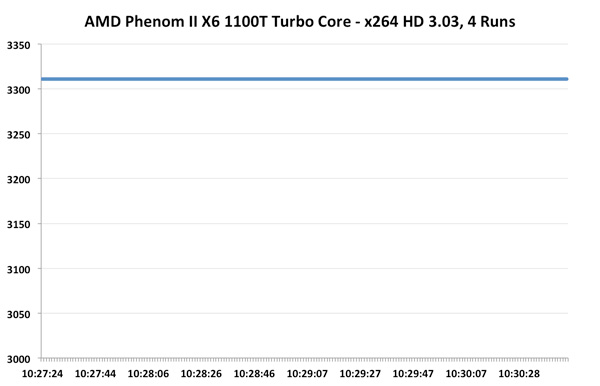
Unfortunately we see nothing of the sort. Turbo Core is pretty much non-functional on the Phenom II X6, at least running this workload. Average clock speed is a meager 3.31GHz, just barely above stock and likely only due to ASUS being aggressive with its clocking.
Now let's look at the FX-8150 with Turbo Core. The base clock here is 3.6GHz, max turbo is 4.2GHz and the intermediate turbo is 3.9GHz:
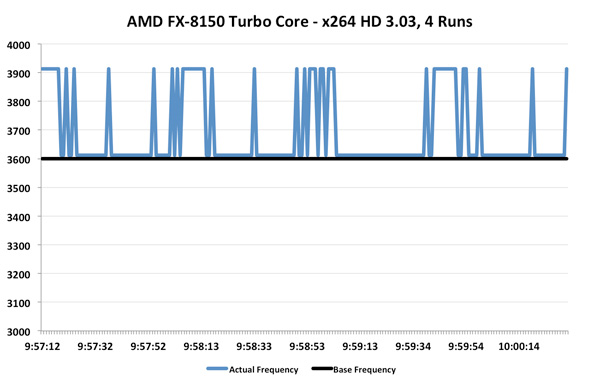
Ah that's more like it. While the average is only 3.69GHz (+2.5% over stock), we're actually seeing some movement here. This workload in particular is hard on any processor as you'll see from Intel's 2500K below:
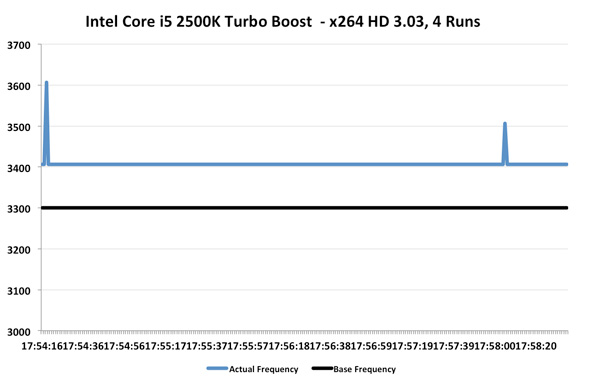
The 2500K runs at 3.3GHz by default, but thanks to turbo it averages 3.41GHz for the duration of this test. We even see a couple of jumps to 3.5 and 3.6GHz. Intel's turbo is a bit more consistent than AMD's, but average clock increase is quite similar at 3%.
Now let's look at the best case scenario for turbo: a heavy single threaded application. A single demanding application, even for a brief period of time, is really where these turbo modes can truly shine. Turbo helps launch applications quicker, make windows appear faster and make an easy time of churning through bursty workloads.
We turn to our usual favorite Cinebench 11.5, as it has an excellent single-threaded benchmark built in. Once again we start with the Phenom II X6 1100T:
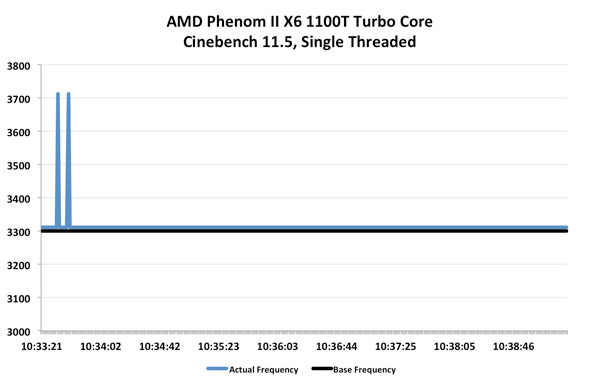
Turbo Core actually works on the Phenom II X6, albeit for a very short duration. We see a couple of blips up to 3.7GHz but the rest of the time the chip remains at 3.3GHz. Average clock speed is once again, 3.31GHz.
Bulldozer does far better:

Here we see blips up to 4.2GHz and pretty consistent performance at 3.9GHz, exactly what you'd expect. Average clock speed is 3.93GHz, a full 9% above the 3.6GHz base clock of the FX-8150.

Intel's turbo fluctuates much more frequently here, moving between 3.4GHz and 3.6GHz as it runs into TDP limits. The average clock speed remains at 3.5GHz, or a 6% increase over the base. For the first time ever, AMD actually does a better job at scaling frequency via turbo than Intel. While I would like to see more granular turbo options, it's clear that Turbo Core is a real feature in Bulldozer and not the half-hearted attempt we got with Phenom II X6. I measured the performance gains due to Turbo Core across a number of our benchmarks:

Average performance increased by just under 5% across our tests. It's nothing earth shattering, but it's a start. Don't forget how unassuming the first implementations of Turbo Boost were on Intel architectures. I do hope with future generations we may see even more significant gains from Turbo Core on Bulldozer derivatives.
Independent Clock Frequencies
When AMD introduced the original Phenom processor it promised more energy efficient execution by being able to clock each core independently. You could have a heavy workload running on Core 0 at 2.6GHz, while Core 3 ran a lighter thread at 1.6GHz. In practice, we felt Phenom's asynchronous clocking was a burden as the CPU/OS scheduler combination would sometimes take too long to ramp up a core to a higher frequency when needed. The result, at least back then, was that you'd get significantly lower performance in these workloads that shuffled threads from one core to the next. The problem was so bad that AMD abandoned asynchronous clocking altogether in Phenom II.
The feature is back in Bulldozer, and this time AMD believes it will be problem free. The first major change is with Windows 7, core parking should keep some threads from haphazardly dancing around all available cores. The second change is that Bulldozer can ramp frequencies up and down much quicker than the original Phenom ever could. Chalk that up to a side benefit of Turbo Core being a major part of the architecture this time around.
Asynchronous clocking in Bulldozer hasn't proven to be a burden in any of our tests thus far, however I'm reluctant to embrace it as an advantage just yet. At least not until we've had some more experience with the feature under our belts.


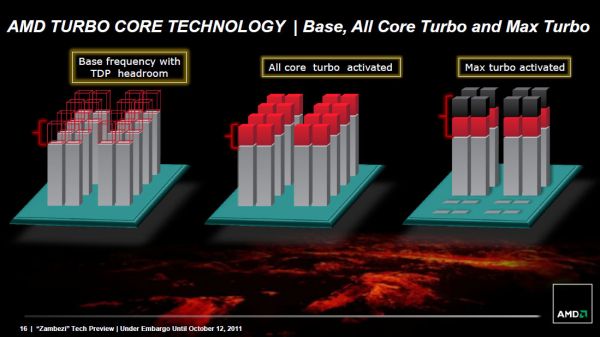








430 Comments
View All Comments
silverblue - Thursday, October 13, 2011 - link
And here's me thinking you were either banned or got lost on another tech site.Oh, by the way, you usually say "craps". Seems your Engrish has improved a little.
SanX - Thursday, October 13, 2011 - link
(to destroy the company).SanX - Thursday, October 13, 2011 - link
"BullShiter"grant2 - Thursday, October 13, 2011 - link
You're the tech expert writing a commercial article... so why can't *YOU* give us a judgement?gvaley - Thursday, October 13, 2011 - link
Reviewers tend to avoid extreme conclusions and in this case, it would have been an extremely conclusive conclusion.cjs150 - Thursday, October 13, 2011 - link
Just got the pricing in the UK.AMD FX-8150 is about £30 or $45 MORE expensive than the i5 2500k but £50 or $75 cheaper than i7 2600k
As Anand said BD can just about hang on to the i5 coat tails (and he is being generous). If the i5 is noticably cheaper what exactly is the point of BD?
Tchamber - Thursday, October 13, 2011 - link
I can understand ebing disappointed in the performance of bd, but when a high end gpu requires 600w, whats another 30w for a cpu? Lower is nice, but how many of us who game and have a nice cpu/gpu combo actually count the watts? Heck, when i got my first i7 920 i got the gtx285 thinking i would later run sli so i have a big psu. Now. I have a i7 970 and the same gpu and can still upgrade to whatever card i want. I tend to think multithreading is still growing, and we will see more apps use more cores, and windows 8 might utilize an fx core more efficiently. But calling bd a failure is rough, amd never said it would trounce anything, we were promised 8 cores and we sorta got them. It is an. Incremental step in the right direction, and i think the future improvements will bear out in favor of this cpu. Just like llano is doing so well in the laptop market, this could do very well in the desktop market.Bytales - Thursday, October 13, 2011 - link
We must ALSO remember the fact that windows 7 does not know of the special bulldozer architecture, and perhaps that has a role too.Once the threads are optimal allocated, perhaps performance will be a little bit better.
eagle-i - Thursday, October 13, 2011 - link
I use linux (opensuse11.4) for everyday work and would love to see if there is any difference.(linux (and other open source software) being open source is far versatile so it is in a better position to take latest cpu advantages offered by amd
I use virtualbox to run windows (in opensuse) [ cant use xen/kvm due to non vt-x/d on intel cpu -- here amd is far better they offer you the latest thereby helping accelerate its adoption]
Also, BD is a new architecture and m sure after refinement it should better AFAIK , its a right step and its now upto AMD if they can pull through with refinement.
GiSWiG - Thursday, October 13, 2011 - link
My Athlon XP 2500 (1.8GHz) overclocked to 2.5GHz stably, smacked any Intel chip. My Athlon X2 was again a nice 700MHz overclock (can't remember model number). I have an Phenom II X4 965BE. 3.4GHz and 8GB of RAM, 1300MHz @ 6-6-6-18. I'm happy with it. From sleep, Win7 is at the login prompt before my monitor wakes up. I've stopped my PC gaming days. I occasionally encode DVDs to high quality x246/mkv (~3hrs per 2hr movie) queued overnight and it is fine.AMD was a powerhouse but I've not been overly impressed since the Bartons. I'm quite happy with my setup. Really, crossfire-ing two highend AMD video cards and I'm set for any game. Gaming performance is dependent on video cards, not CPUs. I'm fine @ 100 FPS vs. 120 FPS. Your eyes will more than likely never see the difference.
AMD made a good business decision taking over ATI. They are beating Nvida in many ways, including game consoles. They allow PC gamers to have adequate motherboard/CPU/RAM combos and use the money they save for higher end video cards. Unfortunately, gamers head to Intel because they think they need they highest end CPU and RAM when they really need to sink more money into video cards.
I think AMD is stronger than most think because of the price/performance ratio. If you only had $1000 to build a gaming PC, you'll be better off spending less money on AMD CPU and more on video and still have a faster PC to spend the same ratio with an Intel setup.
I've always wish for one thing: AMD NEEDS TO ADVERTISE! Come up with a nice 6 note jingle (or 8)!